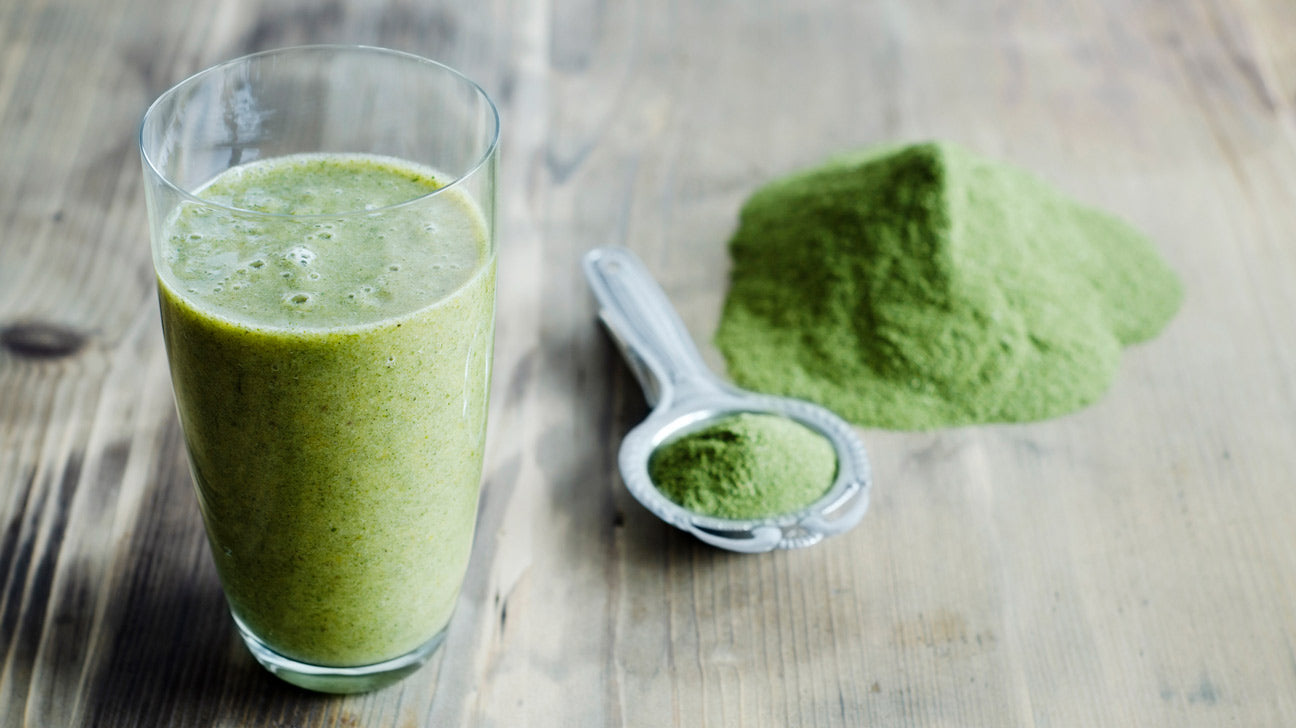
It's 2022 - What's in Your Greens Supplement?
What's in Your Greens Supplement?
If you’re reading this, chances are high that you’ve used a Greens supplement and are aware of the importance of adding a scoop (or two) into your daily routine. From supporting both energy and immune function to increasing antioxidant levels, greens products can also benefit detoxification and acid/alkaline balance.
For these reasons, many consider them on par in importance as an Omega-3 or protein intake, and rightly so! Almost any greens supplement is going to offer at least some of the benefits described above so if you are using one now, keep it up! That said, with so many different products available – and with some being formulated quite some time ago - are there differences that matter? More importantly, what are some of the new innovations that were not available a few years ago that you might want in your daily scoop?
Before you buy your next container, read on to learn about the evolution of your common Greens supplement, including:
- Is Organic Better?
- Vitamin and Mineral Concentrations – How much do I get?
- What about adding some Fruits in with Veggies?
- Advances with Medicinal mushrooms
Is Organic Better?
Spoiler Alert: Yes, and for a couple of reasons that are worthy of consideration.
It is important to know that greens supplements are created by a freeze-drying and dehydration process. Water content in vegetables is very high - up to 96% of the weight - and upon its removal, only a fraction of the food remains (1, 2). When converted to powder and frozen, this preserves the cell wall and nutrient concentration; aka the vitamins, minerals and phytonutrients that make veggies so important!
As an aside, nutrient loss can happen if/when the vegetable cell wall is damaged. One example of this can occur if these ingredients are added to solid pills and then are compressed to save space. For this reason, nearly all greens supplements are sold in powder form, preserving the nutrient density of the original food. If you happen to see green foods listed as ingredients in a hard pill multivitamin, know that they will not deliver the same benefits while also being dramatically underdosed.
When it comes to nutrients, organic foods and conventionally grown vegetables can have similar vitamin and mineral profiles. This is contingent on the crop being allowed to grow to full ripeness AND if the soils used are ‘complete’ in the sense that a full array of fertilizer gives the plant the allotment of nutrients to absorb from the soil. The issue with many conventional fertilizers is that while loaded with minerals N, P and K (nitrogen, phosphorus, potassium all of which promote rapid growth), they are lacking in the (necessary) variety of other critical trace minerals found in compost and organic material. Ironic, that we call this new form of farming “conventional” when it is not a traditional practice and organic farming is seen as the outlier!
In full, organically grown produce enjoys (by virtue of its validated status) certain advantages, including:
- Use of natural fertilizer to provide nutrition vs. synthetic fertilizer
- No chemical pesticides or herbicides to fight pests or weeds during growth
- Non-GMO with a focus on biodiversity and composting
Assume for arguments sake that there is no discernable difference in micronutrient content. The trump Card for organic foods is the second point: the absence of synthetic pesticides and herbicides used during plant growth. For most, that alone makes it worthwhile given the recent concerns surrounding glyphosates (3).
When shopping for your next greens supplement, be aware that greens formulations can be made using all conventionally grown veggies (good), a combination of conventional and organic greens (better) or 100% fully organically grown foods (best). Any product using organic ingredients will very loudly and proudly point this out on their packaging. But this is only just part of the story.
Vitamin and Mineral Concentrations – How much do I get?
Right off the hop, know that most greens products you will find today do not list their vitamin and mineral concentrations. This does not always mean they are lacking or not there; it could simply be that product is making a focus on other

aspects of the formulation. After all, many take greens in addition to a Multi or in combination with additional Zinc, Magnesium or Vitamin C due to the demands they place on their body from stress, training, or line of work and not for mineral support.
That said, for the Greens products that do list vitamin and mineral concentrations, this can be an important way to determine just how potent their raw materials truly are! Imagine one greens product uses heavy concentrations of mineral-rich sea vegetables while another brand uses a fraction of that open, opting for a higher concentration of something less potent, say standard lettuce. This would certainly show up when comparing mineral and vitamin concentrations! Nutrient density is not the same across the spectrum of vegetables and unsurprisingly, better quality raw materials are also more expensive.
Naturally Occurring or Added Vitamins?
Are the micronutrients listed naturally occurring coming solely from the vegetables themselves, or are they added like those in breakfast cereal?
While added vitamins are beneficial, there is a major difference in quality, due to the forms used. As such, they are not as readily absorbed as those found naturally in our whole foods. How can you tell when reading a label if they are added or naturally occurring?
Products with added vitamins and minerals list them as ingredients, often added to fortify the food due to a lackluster amount of naturally occurring micronutrients. Another tell is in how they are named in the vitamin panel although please be aware this is not always the case in food products. As an example, notice (in the cereal label image) how calcium adds a word “carbonate” and the Vitamin C is “ascorbic acid”. These additional words are the “form” of the manufactured vitamin/mineral added to the product. For comparison, the greens product label lists no added vitamins or minerals – they all come from the foods listed as ingredients.
Remember: added vitamins can still be highly absorbable when in the right form.
Suffice to say, all greens formulas will have some amount of naturally occurring micronutrients. When their concentrations are listed on the label and are not found as ingredients, you now know they are whole food sourced.
How about adding some Fruits in with Veggies?
The antioxidant power of fruit is unmatched. Much higher than that of vegetables, fruits offer an edge in our fight against aging. Acai, Pomegranate and Tart Cherry are top tier in their potency which is measured using the ORAC

scale (see side bar). Moreover, choosing different fruit that encompass the entire color spectrum provides a potent array of unique phytochemicals which positively impact the body, notably in both the cardiovascular and immune systems.
With the popularity of low sugar diets, fruit consumption lowers and in the case of a ketogenic approach, is virtually non-existent. Another issue is repetitive food choices (example: eating apples and bananas) which limits the range of antioxidants available to just that narrow field.
For these reasons, opting for a greens supplement that also contains low-sugar, pesticide-free, antioxidant-rich fruit sources is a good insurance policy, especially in winter. Even for those who focus on balanced macro eating, this provides critical compounds from foods most never consume, even occasionally.
Lastly, this combination is also great for taste! Fruits and vegetables require little in the way of flavouring to be palatable and this eliminates the need (although still check that label) for any added sugar or artificial sweetener. Convenient and tasty while respecting your clean eating!
What About those Medicinal Mushrooms?
Mushrooms have been used in Chinese medicine for thousands of years. As adoptogens, they provide support to help combat the effects of stress, offer amazing nootropic benefits and at higher doses, have even been shown to improve athletic performance. This only scratches their surface! Cordyceps, Chaga, Reishi, Maitake and Shiitake are all popular and can be found in some green food formulations.
Anything that can help with focus and stress management these days is nothing less than a great complimentary benefit!
References:
-
17 Vegetables Highest in Water, Whitbread, Daisy April 24, 2022, https://www.myfooddata.com/articles/vegetables-high-in-water.php#vegetables-high-in-water
-
200 Vegetables Highest in Water https://tools.myfooddata.com/nutrient-ranking-tool/Water/Vegetables/Highest/100g/Simple
-
New Analysis of Glyphosate Industry Studies Finds Them Outdated, Flawed, Gillan, Carey July 4, 2021 https://usrtk.org/pesticides/new-analysis-glyphosate-studies/
-
ORAC Values: Antioxidant Values of Foods & Beverages, Updated Jan 28, 2020 https://www.superfoodly.com/orac-values/
-
Haytowitz, D.B., Bhagwat, S.A. 2010. USDA database for the oxygen radical capacity (ORAC) of selected foods, release 2. USDA National Nutrient Database for Standard Reference. Available: http://www.ars.usda.gov/nutrientdata

